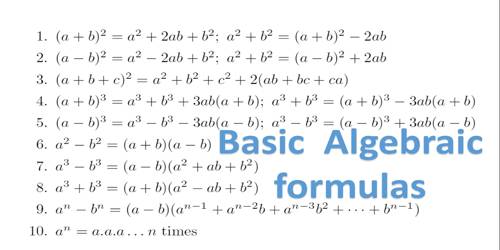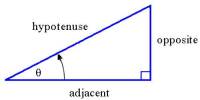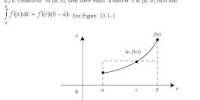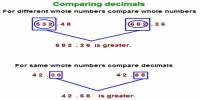List of important Math Formulas and Results
Addition, subtraction, multiplication, and division are easy, what if you come across derivation, calculus, and geometry? You would formulas to solve them. Here present the host of formulas for your reference to solve all important mathematical operations.
Algebra: Laws of Indices:
(i) aᵐ ∙ aⁿ = aᵐ + ⁿ
(ii) aᵐ/aⁿ = aᵐ – ⁿ
(iii) (aᵐ)ⁿ = aᵐⁿ
(iv) a = 1 (a ≠ 0).
(v) a-ⁿ = 1/aⁿ
(vi) ⁿ√aᵐ = aᵐ/ⁿ
(vii) (ab)ᵐ = aᵐ ∙ bⁿ.
(viii) (a/b)ᵐ = aᵐ/bⁿ
(ix) If aᵐ = bᵐ (m ≠ 0), then a = b.
(x) If aᵐ = aⁿ then m = n.
Surds:
(i) The surd conjugate of √a + √b (or a + √b) is √a – √b (or a – √b) and conversely.
(ii) If a is rational, √b is a surd and a + √b (or, a – √b) = 0 then a = 0 and b = 0.
(iii) If a and x are rational, √b and √y are surds and a + √b = x + √y then a = x and b = y.
Complex Numbers:
(i) The symbol z = (x, y) = x + iy where x, y are real and i = √-1, is called a complex (or, imaginary) quantity; x is called the real part and y, the imaginary part of the complex number z = x + iy.
(ii) If z = x + iy then z = x – iy and conversely; here, z is the complex conjugate of z.
(iii) If z = x+ iy then
(a) mod. z (or, | z | or, | x + iy | ) = + √(x² + y²) and
(b) amp. z (or, arg. z) = Ф = tan−1−1 y/x (-π < Ф ≤ π).
(iv) The modulus – amplitude form of a complex quantity z is
z = r (cosф + i sinф); here, r = | z | and ф = arg. z (-π < Ф <= π).
(v) | z | = | -z | = z ∙ z = √ (x² + y²).
(vi) If x + iy= 0 then x = 0 and y = 0(x,y are real).
(vii) If x + iy = p + iq then x = p and y = q(x, y, p and q all are real).
(viii) i = √-1, i² = -1, i³ = -i, and i⁴ = 1.
(ix) | z₁ + z₂| ≤ | z₁ | + | z₂ |.
(x) | z₁ z₂ | = | z₁ | ∙ | z₂ |.
(xi) | z₁/z₂| = | z₁ |/| z₂ |.
(xii) (a) arg. (z₁ z₂) = arg. z₁ + arg. z₂ + m
(b) arg. (z₁/z₂) = arg. z₁ – arg. z₂ + m where m = 0 or, 2π or, (- 2π).
(xiii) If ω be the imaginary cube root of unity then ω = ½ (- 1 + √3i) or, ω = ½ (-1 – √3i)
(xiv) ω³ = 1 and 1 + ω + ω² = 0
Variation:
(i) If x varies directly as y, we write x ∝ y or, x = ky where k is a constant of variation.
(ii) If x varies inversely as y, we write x ∝ 1/y or, x = m ∙ (1/y) where m is a constant of variation.
(iii) If x ∝ y when z is constant and x ∝ z when y is constant then x ∝ yz when both y and z vary.
Arithmetical Progression (A.P.):
(i) The general form of an A. P. is a, a + d, a + 2d, a + 3d,…..
where a is the first term and d, the common difference of the A.P.
(ii) The nth term of the above A.P. is t₀ = a + (n – 1)d.
(iii) The sum of first n terns of the above A.P. is s = n/2 (a + l) = (No. of terms/2)[1st term + last term] or, S = ⁿ/₂ [2a + (n – 1) d]
(iv) The arithmetic mean between two given numbers a and b is (a + b)/2.
(v) 1 + 2 + 3 + …… + n = [n(n + 1)]/2.
(vi) 1² + 2² + 3² +……………. + n² = [n(n+ 1)(2n+ 1)]/6.
(vii) 1³ + 2³ + 3³ + . . . . + n³ = [{n(n + 1)}/2 ]².
Geometrical Progression (G.P.) :
(i) The general form of a G.P. is a, ar, ar², ar³, . . . . . where a is the first term and r, the common ratio of the G.P.
(ii) The n th term of the above G.P. is t₀ = a.rn-1
(iii) The sum of first n terms of the above G.P. is S = a ∙ [(1 – rⁿ)/(1 – r)] when -1 < r < 1
or, S = a ∙ [(rⁿ – 1)/(r – 1) ]when r > 1 or r < -1.
(iv) The geometric mean of two positive numbers a and b is √(ab) or, -√(ab).
(v) a + ar + ar² + ……………. ∞ = a/(1 – r) where (-1 < r < 1).
Theory of Quadratic Equation:
ax² + bx + c = 0 … (1)
(i) Roots of the equation (1) are x = {-b ± √(b² – 4ac)}/2a.
(ii) If α and β be the roots of the equation (1) then,
sum of its roots = α + β = – b/a = – (coefficient of x)/(coefficient of x² );
and product of its roots = αβ = c/a = (Constant term /(Coefficient of x²).
(iii) The quadratic equation whose roots are α and β is
x² – (α + β)x + αβ = 0
i.e. , x² – (sum of the roots) x + product of the roots = 0.
(iv) The expression (b² – 4ac) is called the discriminant of equation (1).
(v) If a, b, c are real and rational then the roots of equation (1) are
(a) real and distinct when b² – 4ac > 0;
(b) real and equal when b² – 4ac = 0;
(c) imaginary when b² – 4ac < 0;
(d) rational when b²- 4ac is a perfect square and
(e) irrational when b² – 4ac is not a perfect square.
(vi) If α + iβ be one root of equation (1) then its other root will be conjugate complex quantity α – iβ and conversely (a, b, c are real).
(vii) If α + √β be one root of equation (1) then its other root will be conjugate irrational quantity α – √β (a, b, c are rational).
Permutation:
(i) ⌊n (or, n!) = n (n – 1) (n – 2) ∙∙∙∙∙∙∙∙∙ 3∙2∙1.
(ii) 0! = 1.
(iii) A number of permutations of n different things taken r ( ≤ n) at a time ⁿP₀ = n!/(n – 1)! = n (n – 1)(n – 2) ∙∙∙∙∙∙∙∙ (n – r + 1).
(iv) A number of permutations of n different things taken all at a time = ⁿP₀ = n!.
(v) Number of permutations of n things taken all at a time in which p things are alike of a first kind, q things are alike of a second kind, r things are alike of a third kind and the rest are all different, is ⁿ<span style=’font-size: 50%’>!/₀
(vi) A number of permutations of n different things taken r at a time when each thing may be repeated upto r times in any permutation is nʳ.
Combination:
(i) Number of combinations of n different things taken r at a time = ⁿCr = n! / r!(n−r)!
(ii) ⁿP₀ = r!∙ ⁿC₀.
(iii) ⁿC₀ = ⁿCn = 1.
(iv) ⁿCr = ⁿCn-r.
(v) ⁿCr + ⁿCn-1 = n+1Cr
(vi) If p ≠ q and ⁿCp = ⁿCq then p + q = n.
(vii) ⁿCr/ⁿCr – 1 = (n – r + 1)/r.
(viii) The total number of combinations of n different things taken any number at a time = ⁿC₁ + ⁿC₂ + ⁿC₃ + …………. + ⁿC₀ = 2ⁿ – 1.
(ix) The total number of combinations of (p + q + r + . . . .) things of which p things are alike of a first kind, q things are alike of a second kind r things are alike of a third kind and so on, taken any number at a time is [(p + 1) (q + 1) (r + 1) . . . . ] – 1.
Logarithm:
(i) If ax = M then loga M = x and conversely.
(ii) loga 1 = 0.
(iii) loga a = 1.
(iv) a logam = M.
(v) loga MN = loga M + loga N.
(vi) loga (M/N) = loga M – loga N.
(vii) loga Mn = n loga M.
(viii) loga M = logb M x loga b.
(ix) logb a x 1oga b = 1.
(x) logb a = 1/logb a.
(xi) logb M = logb M/loga b.
Information Source;
















